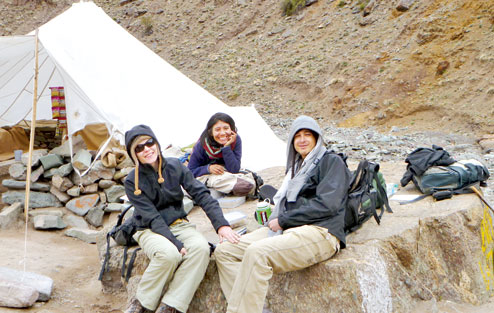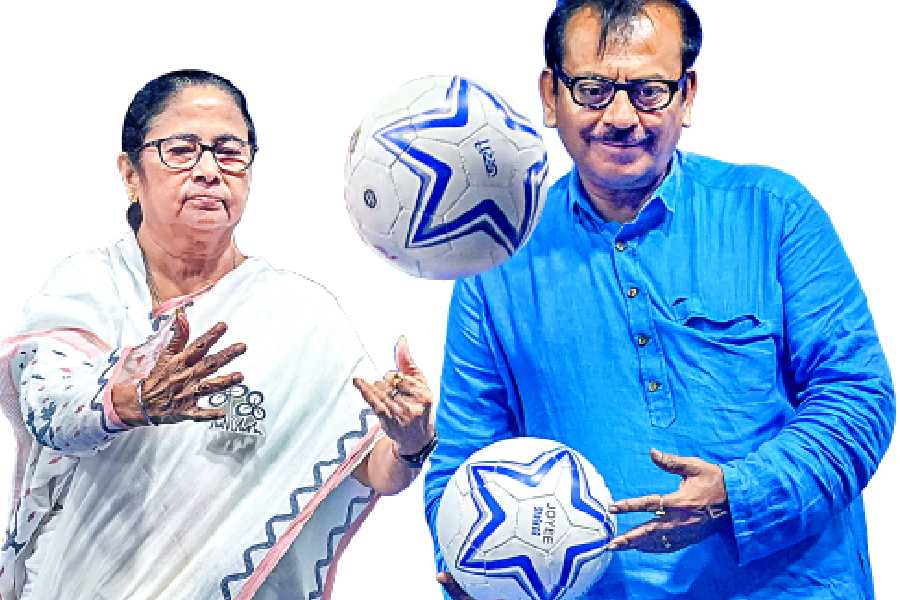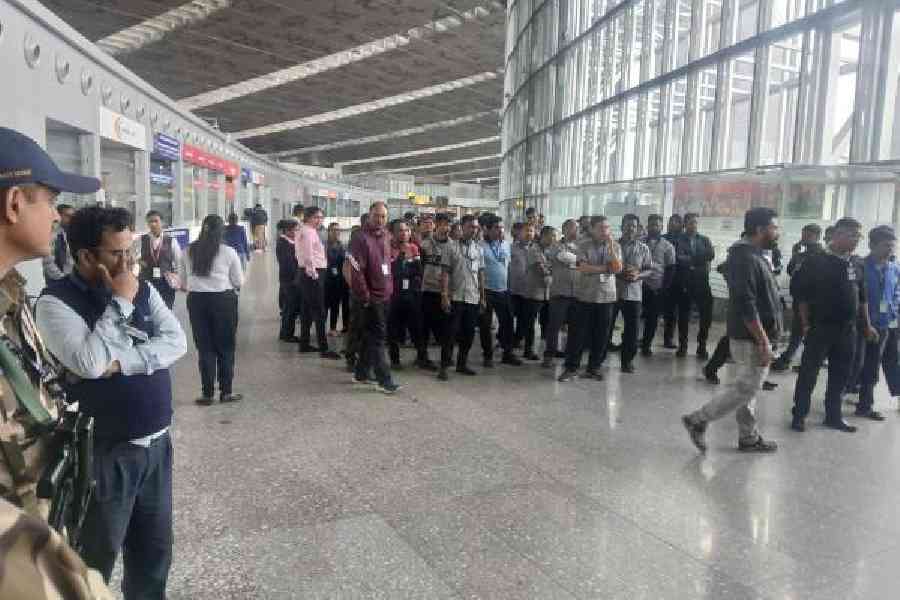 |
| Uphill task: Thinlas Chorol (centre) with foreign tourists and (below) Chorol |
She is a revolutionary but she doesn’t wear fatigues. Thinlas Chorol is a tiny powerhouse of a woman who is adventurously breaking gender barriers at an altitude of over 11,500 feet. From an office in the heart of Leh, she runs India’s first all-woman trekking guide service.
As winter recedes and Ladakh comes out of hibernation, Chorol, 32, prepares for the Ladakhi Women’s Travel Company, or LWTC’s, fourth year of treks that kick off next month.
The LWTC is owned and staffed by women — and runs mainly for women. It also accepts men’s groups and mixed couples, which hasn’t gone down very well with many Ladakhis — one, they argue, just doesn’t go traipsing off with strangers in the wilderness.
“A friend was against my going with two men from Europe as their cook and guide to Rumtek and Tso-moriri for nine days,” Chorol recalls with the widest of smiles fully capable of melting snow when turned full throttle.
LWTC has its counterparts in other parts of Asia. Women’s trekking companies such as 3 Sisters Adventure Trekking in Nepal and Kawla in Myanmar have already made their presence felt on a rugged terrain which has traditionally been a male preserve.
But after the Ladakh group was set up, it almost immediately found takers, mainly among foreign tourists, and particularly among the women. “Everyone wanted someone safe to go with,” Chorol says.
 |
Journeying across Asia, Swiss trekking couple, 40-somethings Esther Wolfensberger and Stefan Schmid, were looking to combine trekking and cultural tourism. “We like to experience local culture but find it more difficult to get in contact with women in India than with men. So we were happy to discover LWTC’s bright orange leaflets at our guesthouse in Leh,” says Wolfensberger.
The couple did two back-to-back LWTC treks: an eight-day Markha Valley trek and later the Lamayuru-Alchi route. “We were lucky to get their last guide. The company is booked out fast. I mean, which solo woman trekker would not prefer booking with a woman guide,” she exclaims.
Besides Chorol, they were accompanied by a young woman called S. Angmo, who had dared to become a trainee guide after meeting Chorol at Jammu University. “She is inspiring. She is very unapologetic about who she is and she stands up for people,” says Angmo, who ultimately yielded to her parents’ wish to take up a more “ladylike” job and become a teacher.
Chorol’s journey of course hasn’t been easy. When she began to look for work as a mountain guide in Ladakh’s stunning destinations of Sham and Alchi and Stok and Darsha, she found the going uphill. She took up jobs as porter, cook and freelance guide for a tour company.
Then she went as a guide, but mostly as a guard, with a Hungarian woman and her group to Markha Valley for a week. At that time there were no official homestays so they put up at a shepherd’s home. “It was a good trip. The Hungarians started speaking English to me. They did not know Ladakh, and mistook me for Japanese or Korean. They were surprised to know that I was local. The woman said they had never seen an Indian woman as a guide,” Chorol recounts. The Hungarian tourist had had unpleasant misadventures with male guides in Nepal and suggested to Chorol she take up being a guide full-time.
Not everyone was as encouraging. Tour companies in Leh told her: “A woman guide would be considered strange.” One non-government organisation backed out from an offer to support her agency.
A mentor at Secmol — the Students’ Educational and Cultural Movement of Ladakh — sponsored her mountaineering training and ambitions which would lead to the LWTC in 2009. She rented office space in Leh’s Hemis Complex, owned by Buddhist monks, and borrowed Rs 20,000 from her father for a computer.
Her parents, like many others in Ladakh, are farmers. Chorol is the youngest of seven children. She was in Takmachik, 120km from Leh, and grew up herding goats and sheep. But always smitten by the mountains, she knew she was different. Restless, inquisitive and fearless.
“Ladakhis are scared of what people will say. I feel you should not worry about society. My inspiration is my sister. She was widowed when I was in school. She lives in the village. She has put up with hardship and gossip. She would say, don’t get married,” says Chorol, who followed her sister’s advice only partly. Two years ago, she married Lars Lidstrom, a Sri Lankan-born Swede, whom she met at a Secmol event.
Lidstrom does not trek. “There can’t be two more opposite people,” says the tall Swede.
Apart from women travellers feeling a measure of equanimity with women guides, is there any difference between the sexes when it comes to guiding? Wolfensberger ponders. “The male guides we had sometimes walked way in front of us (they always had less weight with their backpacks) and the women usually stayed with us or we could still see and call them. ‘Our’ women were less self-conscious than the men, though a little shy. They were also more honest and did not pretend to know something, if they did not.”
Chorol doesn’t see the need for pretence, which implies fear. “I am not scared of anything. I like dangerous mountain passes. I don’t love make-up, I love the mountains. I don’t like Leh. I like the peaks,” smiles this Ladakhi, recently back from ski training in snow-covered Zanskar. And the smile, again, looks set to melt the snow.










